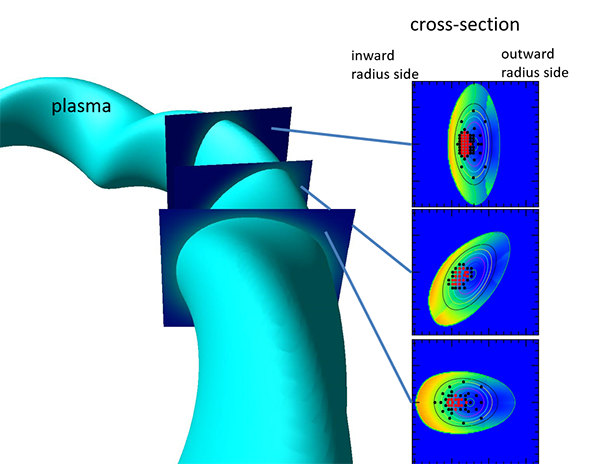HOME > Research Activities > Research Updates >
In the future production of fusion energy, together with maintaining high-temperature plasma, from outside we will continue to supply hydrogen isotope (hereafter as hydrogen), which will become fuel, for continuing the fusion reaction. In order to achieve this, an important issue is establishing an effective fuel supply method for supplying hydrogen into the plasma core. Here, we will introduce computer simulation research regarding the pellet injection method using solid hydrogen.
The pellet injection method is one in which the pellet is injected into the plasma confined by the magnetic field. The frozen hydrogen (pellet) at the extremely cold temperature of -263 degrees is injected at the high speed of one kilometer per second. Because the pellet is electrically neutral it can enter the inside of the plasma without the influence by the magnetic field. The injected pellet advances inside the plasma while ablating. Because the plasma temperature exceeds one hundred million degrees, the pellet ablates completely before it reaches the plasma core, and becomes a cloud of the high density plasma (plasmoid). Having become a plasmoid, because of its charge, its motion is influenced by the magnetic field. For example, the plasmoid, when there is a gradient in the magnetic field strength, moves from the strong side of the magnetic field to the weak side. Using such a characteristic, if we can control the movement and direct it toward the plasma core, then an effective fuel supply can be achieved.
In machines that confine a plasma by the magnetic field in a doughnut configuration, there are tokamak devices and helical devices. When we compare the doughnut configuration to a tire tube, there are near and far radii from the center of the tire’s revolution. Here we will call these the inward radius and the outward radius. The magnetic field of the tokamak device is strong on the inward radius side, and weakens on the outward radius side. Thus, when we inject a pellet from the inward radius side the plasmoid that appears receives the force from the gradient of the magnetic field. And in the magnetic field’s weak direction, that is, it moves toward the core of the plasma with the hottest temperature. In a tokamak device, making use of this characteristic, we inject a pellet from the inward radius side and achieve effective fueling.
On the other hand, in the Large Helical Device (LHD), the superconducting coils, which are in a twisted shape, have been placed so that the plasma is enclosed. Near these coils the magnetic field becomes stronger (differing from the tokamak device, the magnetic field on the inward radius side of the doughnut is not necessarily always strong). Using results from a tokamak as a point of reference, in LHD plasma experiments we injected a pellet from a place directly below the coil where the magnetic field is strong. The movement of the plasmoid in the direction of the plasma core with a weak magnetic field was not observed. Thus, in order to clarify the reason for this we performed simulations on a supercomputer. As a result, we learned that the movement of the plasmoid was not only dependent on the gradient of the magnetic field strength. It was also related to the “tension of the magnetic field lines.”
When one pulls a bowstring, the bowstring will seek to return to its original position by tension. A similar tension is found in the magnetic field lines. The movement of the plasmoid is also influenced by the tension. The tension is particularly strong in the inward radius side of the LHD, thus the influence of the tension becomes greater than the influence of the gradient of the magnetic field strength. Thus, we learned that the plasmoid does not necessarily move in the direction of the weak magnetic field, it also moves in the direction of the strong magnetic field. On the other hand, in a tokamak device, because the influence of the tension upon the magnetic field lines is weak the plasmoid always moves in the direction of the weak magnetic field. Therefore, in the LHD, we cannot make the plasmoid move toward the core plasma by using the same method as the tokamak. Thus, in various places in the LHD we calculated the force required to move the plasmoid, and we clarified the location from where the plasmoid moved toward the plasma core. In the future, we will improve the pellet injection method where structures called “magnetic islands” are found in the magnetic field that confines the plasma.(See back number 295.)

LHD doughnut configuration plasma and three cross-sections When the plasmoid is located in the red circle, it moves toward the core plasma. When the plasmoid is located in the black circle, it does not move toward the core. That is, when the pellet ablates in the red circle area, we can supply fuel to the plasma core. The gradations in the cross-sections depict the tension of the magnetic field lines, and the tension is large following the change from the blue color to the red color. We have learned that the tension in the LHD on the inward radius side grows larger.
